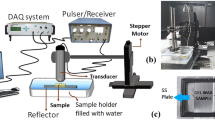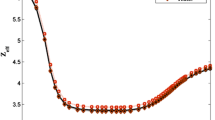Abstract
Ultrasonic imaging is able to detect structural changes due to chemical reactions occurring due to ionizing irradiation. The purpose of this study to create a gel phantom dosimeter (developed MAGIC gel), which has ultrasonic properties equivalent to human tissue for readout with ultrasonic imaging. The speed of sound and the attenuation coefficient were determined as a function of the absorbed dose in the range of 0–50 Gy by using this dosimeter. A gel phantom was prepared by adding MAGIC polymer gel proprietary combinations in ultrasonic soft tissue-mimicking gel. Then, the ultrasonic parameters (response) of the samples, including the propagation speed of sound (SOS) and the attenuation coefficient (BUA) were measured in the absorbed dose range of 0-50 Gy in steps 2 Gy. The dose response curve is plotted and a sigmoid function is fitted. Ultrasonic images were recorded to assess the quality of the novel gel phantom. At 24 h postirradiation, the gel samples were imaged by using a magnetic resonance (MR) scanner. The mean values of the transverse relaxation rates (R2) were taken. The sensitivities of the speed of sound and the attenuation coefficient parameters and the R2 parameter were determined for the soft tissue-mimicking ultrasonic gel phantom. The concentrations of gel phantom, including 14% gelatin, 0.25% graphite, and 2% formaldehyde, with a maximum variation in the speed of sound (21.9 ± 2.3, 20.5 ± 2.1, and 24.3 ± 3.3 m/s) and attenuation coefficient (49.6 ± 9.1, 29.5 ± 5.5, and 47.9 ± 15.4 dB/MHz·m) were selected, respectively. The sensitivities of the speed of sound and the attenuation coefficient parameters and the R2 parameter were determined for the soft tissue-mimicking ultrasonic gel phantom as 1.01 m/s, 2.9 dB/MHz-m, and 0.48 s−1 per Gy and for the MAGIC-f polymer gel as 0.79 m/s, 1.9 dB/MHz-m, and 0.26 s−1 per Gy (R = 0.98), respectively. A significant correlation was found between the MAGIC-f polymer gel and the ultrasonic soft tissue-mimicking gel phantom with the R2 parameter (R = 0.9). Thus, the ultrasonic tissue-mimicking gel phantom can be concluded to be suitable for read-out using ultrasound waves as a free radical polymerization sensor. The cost effectiveness due to the utility of edible gelatin and the formation of breast soft tissue-mimicking ultrasonic images due to the presence of graphite scattering particles are distinctive features of the gel phantom introduced in this study.
Similar content being viewed by others
References
S. Hayashi et al., Radiat. Phys. Chem. 79, 803 (2010).
Y. De Deene, J. Phys. Conf. Ser. 3, 34 (2004).
C. Baldock, J. Phys. Conf. Ser. 777, 12 (2017).
Sh. Smith et al., Med. Phys. 42, 6798 (2015).
M. Lepage et al., Med. Biol. 46, 2827 (2001).
M. L. Mather et al., Phys. Med. Biol. 47, 4397 (2002).
A. J. Venning, K. N. Nitschke, P. J. Keall and C. Baldock, Med. Phys. 32, 1047 (2005).
S. Brown et al., Appl. Radiat. Isot. 66, 1970 (2008).
M. Oldham and L. Kim, Med. Phys. 31, 1093 (2004).
M. Hilts, C. Audet and C. Duzneli, Phys. Med. Biol. 45, 2559 (2000).
J. V. Trapp, S. A. Back and M. Lapage, Phys. Med. Biol. 46, 2939 (2001).
L. Rintoul, M. Lepage and C. Baldock, Appl. Spectrosc. 57, 51 (2003).
Y. Watanabe, L. Warmington and N. Gopishankar, World J. Radiol. 9, 112 (2017).
M. Mokhtari-Dizaji, Ultrasound Med. Biol. 27, 1713 (2001).
E. L. Madsen, G. R. Frank and F. Dong, Ultrasound Med. Biol. 24, 535 (1998).
M. O. Culjat, D. Goldenberg, P. Tewari and R. S. Singha, Ultrasound Med. Biol. 36, 861 (2010).
J. P. Fernandes, B. F. Pastorello, D. B. Araujo and O. Baffa, Phys. Med. Biol. 53, N53 (2008).
H. Masoumi, M. Mokhtari-Dizaji, A. Arbabi and M. Bakhshandeh, Dose-Response 14, 1 (2016).
M. V. Papoutsaki et al., Phys. Med. 2, 1 (2013).
J. W. A. Findlay and R. F. Dillard, AAPS J. 9, 260 (2017).
J. F. Pavoni and O. Baffa, Radiat. Meas. 47, 1074 (2012).
J. J. Luci, H. M. Whitney and J. C. Gore, Phys. Med. Biol. 52, N241 (2007).
S. Khoei, J. V. Trapp and C. M. Langton, J. Phys. Conf. Ser. 59, 444 (2014).
Acknowledgments
This study was approved by Faculty of Medical Sciences, Tarbiat Modares University.
Author information
Authors and Affiliations
Corresponding author
Rights and permissions
About this article
Cite this article
Goharpey, N., Mokhtari-Dizaji, M. & Bakhshandeh, M. A Novel Ultrasonic Gel Phantom Dosimetry for Evaluation of the Dose Response. J. Korean Phys. Soc. 77, 1238–1247 (2020). https://doi.org/10.3938/jkps.77.1238
Received:
Accepted:
Published:
Issue Date:
DOI: https://doi.org/10.3938/jkps.77.1238




